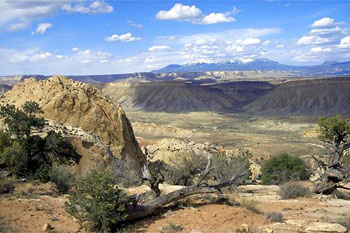Rainbow Wilderness
When we entered the canyon, down about 10 miles from where we are now, there were even more colors to keep the eyes overwhelmed. The chinle day layers were exposed beneath the sandstone, leaving layer upon layer of wildly colored strata visible. In some areas, more than 30 distinct layers of so many colors were angled up towards the massive monocline called the cockscomb. Brown, yellow, purple, gray, beige and tan, and an array that only a cosmetic salesgirl could begin to name.
The weather has finally turned nice, after over two weeks of cold, rainy days. We’re enjoying the sun and temperatures in the 80s. Good thing too. The water is cold and there are many crossings. Last night, I noted that it was fully 30 degrees warmer than at the same time three nights ago. I finally don’t have to layer up to be comfortable in my 45 degree down sleeping bag. My tent is for rain rather than warmth.
Here comes another rant…ATVs! For some reason, this monument allows unrestricted ATV access in a WSA. Today, we saw almost 30 of them, many of which apparently couldn’t be troubled to stay in the river bed or on trails. These people selfishly bully us into allowing them virtually everywhere, ridiculously citing “traditional” use – as if they rode these destructive, noisy machines even 20 years ago. The real traditional use seems to me to be walking and hunting and gathering, not tearing through the living crypt biotic soils while trying to “see” an entire river corridor in a day.
Even the use of horses is barely 100 years old in this desolate part of the American West. I’m sure these machines are fun, but do they really belong in a place special enough to receive protective designations by both republican and democrat administrations? I wonder what ol’ Hayduke would have to say about it….
Day 39
Round Valley Draw, Hackberry Canyon, the Paria River, Sheep Creek, and finally, Willis Creek; section eight’s wondrous drainages. Slot canyons, clear springs, wildly colored rock, fascinating ancient pictographs (those that are painted on rock) and petroglyphs (those that are etched or pecked into rock). Some are the most amazing I’ve ever seen, even cowboy / pioneer signatures dating back to the 1800’s when this land was still being settled by white folks, much of the region still unexplored.
We’ve all enjoyed this now completed section immensely, despite sunburn, chilly nights, snake encounters, morons on ATVs, quicksand and slippery wash bottoms. I even had my own quicksand “adventure” while exploring alone in a side canyon off the Paria River. I fell up to my thighs in a trap, tossing me forward as my body continued in the direction my feet could no longer lead me to. My arms went out instinctively to break my fall, but both sank into the goop nearly to my shoulders. Fortunately, a quick roll to the edge of the stream got me out, leaving me covered head to toe in sand, shaking with both adrenaline and fear.
Day 41
We’re now camped just outside the boundary of Bryce Canyon National Park, the fourth of six parks along the Hayduke Trail. The colorful cliffs have been drawing closer for a couple of days, the runoff from the snow covered Paunsaugant Plateau clearly showing its origin in the pink cliffs. Willis Creek led us all the way to Bryce’s Under-the-Rim Trail, which conveniently skirts the park boundary, allowing us to simply pop out of the park for free, permit less camping.
Bryce seems a little different than most of the journey so far. We’ve climbed to over 8000ft through aspens and ponderosas. Some of the shaded parts of the trail still have snow across it, and there has yet to be any maintenance on the trail this year. We are constantly having to work around fallen trees and slide-out areas. But that keeps a huge majority of folks off the trail. We’ve yet to see anyone else out here and only a couple of footprints.
We’ll now make a dash for the border of Arizona, where we’ll hop on the Arizona Trail, which will lead us to the just-opened North Rim of the mighty Grand Canyon, a mere 11 days, and more than 110 miles away!
Keep it wild!
From a happy and thinner Mike Coronella



 Subscribe to Mike and Mitch's RSS Feed
Subscribe to Mike and Mitch's RSS Feed
